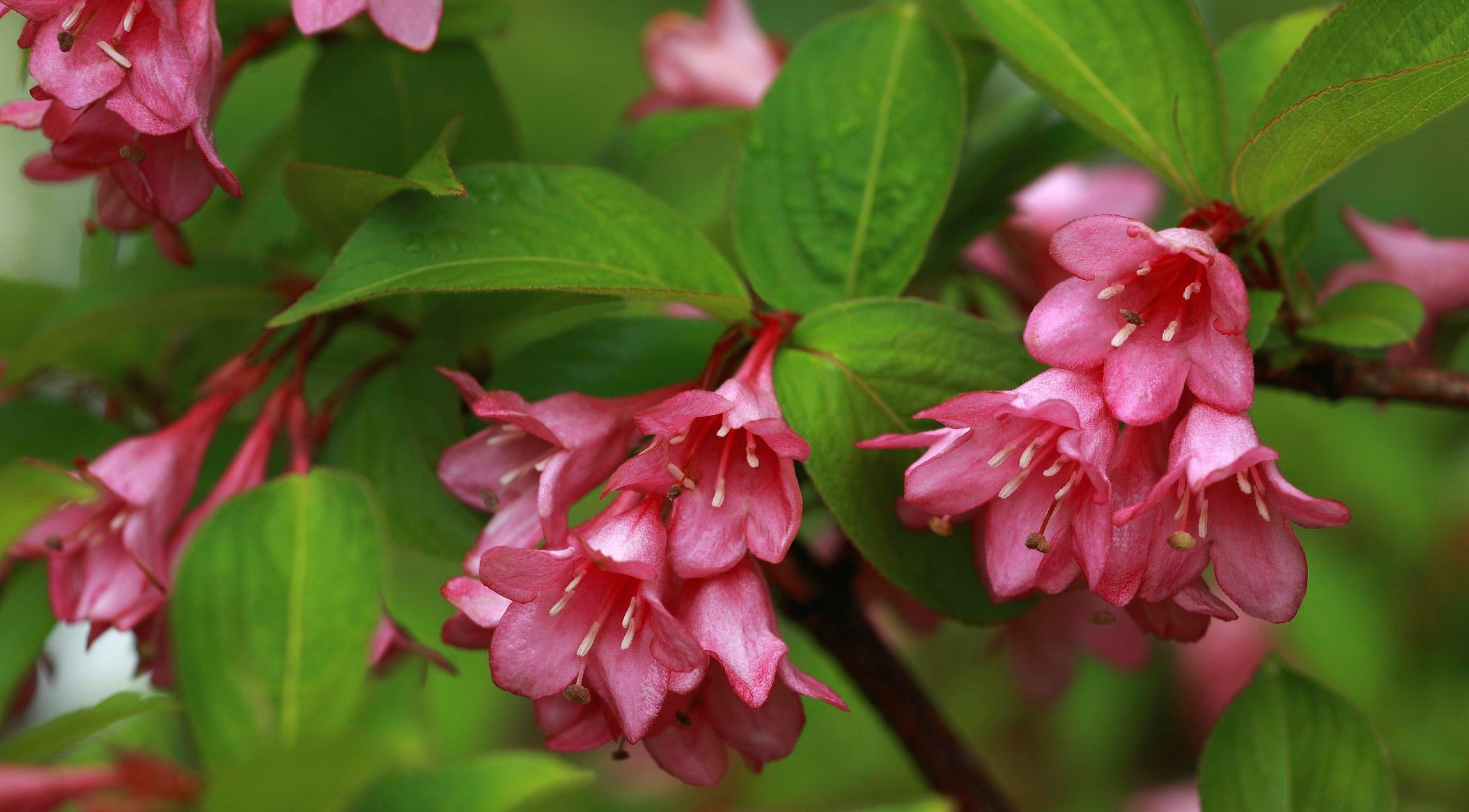Growing Weigela

For sheer romantic charm, few ornamental plants rival the character and beauty of weigela. This old-fashioned deciduous shrub, which bears profuse clusters of flowers in spring, is virtually carefree, save for a bit of pruning and watering. The tubular-shaped flowers, which come in various hues, are especially attractive to hummingbirds and butterflies. With a wide range of foliage colors—from creamy variegation to nearly black—and an array of sizes, there’s a suitable variety for nearly any landscape need.
A member of the honeysuckle family, weigela is native to parts of Asia, and was first imported to Europe in the 1800s. Hardy in many regions of the US, breeding breakthroughs have resulted in newer cultivars with different colors, increased vigor, and compact sizes that are suited for smaller yards.
Zones: 4-8, with a few exceptions.
Height/Spread: Arching, upright, mounding or spreading habit; size varies from 12 inches tall and 18 inches wide, up to 10 feet tall and 12 feet wide.
Exposure: Plants will bloom most prolifically in full sun, but can tolerate partial shade. Varieties with gold, chartreuse or purple foliage will hold their color better in full sun. Those with variegated foliage can burn with too much afternoon sun in hotter climates.
Bloom time: Mid-late spring, with sparser rebloom in summer and fall.
Color and characteristic: These deciduous shrubs produce tubular five-lobed flowers, 1-2 inches long. Flowers come in shades of red, pink, white and yellow. Foliage is 2-6 inches long, sometimes glossy, and oblong-shaped with a slightly serrated edge. Leaves are green, chartreuse, gold, variegated, burgundy or deep purple. Fall color is insignificant.
Toxicity: Weigela is not considered toxic to pets or children.
Planting
When to plant weigela
- Cooler months during spring or fall are the best time to plant to avoid transplant shock from extreme summer heat.
Where to plant weigela
- Choose a sunny site with moist, well-draining soil. Consider a spot where you can enjoy the blooms from inside and out and watch the hummingbirds dart about.
How to plant weigela
- Dig a hole to the same depth as the root ball and 2-5 times as wide. Break up the soil and mix 15-20% compost into the backfill. If the plant is root bound, tease out the roots or slice the root ball in several places. Set the plant in the hole and cover the root ball with backfill to just below the top of the rootball; avoid covering the top of the rootball or the stem with soil. Water deeply, then mulch with loose organic matter, avoiding the stem. Continue to water regularly until established.
Care
How to prune zinnia
- Remove any dead branches in early spring when the shrub is starting to leaf out. Since weigela blooms on the previous year’s growth, any other pruning and shaping should wait until after spring flowering. Prune back to a healthy set of lateral shoots, which will allow for vigorous growth and flower buds for next season. Dwarf varieties need little, if any pruning. Larger mature specimens benefit from the removal of older branches to rejuvenate the plant. In late winter or early spring, trim out no more than one-third of the oldest branches at the base. This can be repeated every few years. See step by step how to prune hopuseplants.
Watering:
Once established, weigela need little to no supplemental water, unless the climate is exceptionally hot and dry.
Soil:
Weigela grows best in moderately acidic to slightly alkaline soil, with a pH between 5.5 and 7.5. Soil should be moist and well-draining.
Amendments & fertilizer:
Apply a balanced slow-release fertilizer in early spring around the root zone according to package instructions. Mulch with several inches of organic matter to add nutrients, suppress weeds and conserve water.
Deer resistance:
Deer will leave weigela alone for the most part, though extreme conditions can result in deer grazing on plants they wouldn’t otherwise.
Pests/Diseases
- Healthy specimens are virtually free of pests and diseases. Possible insect problems include aphids, spider mites, mealy bugs, or scale. Fungal diseases can include powdery mildew, botrytis, twig blight or leaf spot.
Website: www.gardendesign.com